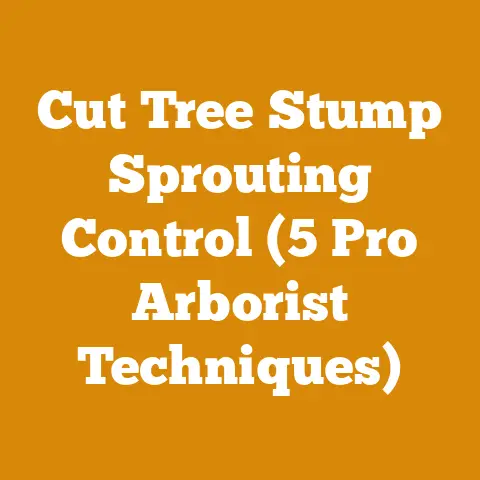Chuck and Duck Chippers Compared (5 Pro Arborist Tips)
Chuck and Duck Chippers Compared: 5 Pro Arborist Tips to Maximize Your Investment
Ever stood before a mountain of brush, the daunting task of chipping it all stretching out like a never-ending workday?
I have.
More times than I care to admit.
And each time, the question nags: “Am I using the right chipper for this job?” The choice between a “chuck and duck” style chipper and other types can feel like choosing between a trusty old axe and a high-tech chainsaw – both get the job done, but one is often faster, more efficient, and ultimately, less back-breaking.
In this article, I’m diving deep into the world of “chuck and duck” chippers, comparing them to other chipper types, and sharing five hard-earned tips I’ve gleaned from years in the field.
We’ll dissect the pros and cons, explore real-world cost considerations, and arm you with the knowledge to make an informed decision for your specific needs.
Let’s get started!
What is a “Chuck and Duck” Chipper Anyway?
Before we get too far ahead of ourselves, let’s define what we’re talking about.
A “chuck and duck” chipper, also known as a gravity-feed chipper, is a type of wood chipper where the operator manually feeds branches and debris into a hopper.
The machine relies on gravity and the force of the rotating blades to pull the material through and chip it.
The term “chuck and duck” comes from the action of quickly feeding the material (“chuck”) and then stepping back (“duck”) to avoid kickback or debris.
Chuck and Duck vs. Other Chipper Types: A Head-to-Head Battle
The chipper market is a crowded one.
Let’s see how the “chuck and duck” stacks up.
- Drum Chippers: These beasts use a large rotating drum with knives mounted on it.
They’re incredibly powerful and can handle much larger diameter branches than “chuck and duck” models.
However, they’re also significantly more expensive and require more maintenance. - Disc Chippers: Similar to drum chippers, disc chippers use a large rotating disc with knives.
They’re generally lighter and more maneuverable than drum chippers, making them a good option for smaller operations. - Hydraulic Feed Chippers: These chippers use hydraulic rollers to automatically pull material into the chipping blades.
This eliminates the need for manual feeding, increasing efficiency and reducing operator fatigue.
They’re a significant investment, but the productivity boost can be worth it for high-volume operations. - PTO Chippers: These chippers are powered by the power take-off (PTO) of a tractor.
They’re a good option for farms or properties that already have a tractor.
The cost-effectiveness depends on the frequency of use and the initial investment in the tractor.
Let’s put this into a table for easy comparison:
Pro Arborist Tip #1: Understand Your Volume and Wood Type
The first, and arguably most crucial, step is to accurately assess the volume and type of wood you’ll be chipping.
Are you primarily dealing with small branches and shrubs from residential tree trimming, or are you tackling larger diameter limbs from storm cleanup?
Are you chipping softwoods like pine and fir, or hardwoods like oak and maple?
- Volume: If you’re only chipping a few cubic yards of material per week, a “chuck and duck” chipper might suffice.
However, if you’re dealing with dozens of cubic yards, the manual feeding process will quickly become exhausting and inefficient. - Wood Type: Hardwoods require more power to chip than softwoods.
A “chuck and duck” chipper with a smaller engine might struggle with hardwoods, leading to frequent jams and reduced chipping capacity.
Cost Implications:
- Labor Costs: Manual feeding increases labor costs, especially with high volumes.
Consider the hourly wage of your crew and the time spent feeding the chipper versus other tasks.
For example, if a crew member earns $25/hour and spends 4 hours per day feeding a “chuck and duck” chipper, that’s $100 in labor costs per day.
A hydraulic feed chipper could potentially cut that time in half, saving $50 per day. - Maintenance Costs: Overworking a “chuck and duck” chipper beyond its capacity can lead to increased wear and tear, resulting in higher maintenance costs.
- Disposal Costs: Inefficient chipping can result in larger, less uniform chips, which may be more expensive to dispose of.
Data Point: According to the U.S.
Forest Service, the average cost of disposing of wood waste at a landfill is $55 per ton.
Inefficient chipping can increase the volume of waste, leading to higher disposal costs.
My Experience: I once took on a job clearing a large property overgrown with dense brush and small trees.
I initially tried using a small “chuck and duck” chipper, thinking it would be sufficient.
However, I quickly realized that the volume of material was far too great, and the chipper was constantly getting jammed.
I ended up renting a hydraulic feed chipper, which significantly increased my productivity and reduced my labor costs.
The rental fee, while initially daunting, paid for itself in the long run.
Pro Arborist Tip #2: Horsepower Matters (More Than You Think)
Don’t underestimate the importance of horsepower.
A chipper with insufficient horsepower will struggle to handle larger diameter branches and dense hardwoods, leading to reduced chipping capacity, frequent jams, and increased wear and tear.
- Matching Horsepower to Material: As a general rule, I recommend at least 15 horsepower for chipping branches up to 4 inches in diameter.
For larger branches and hardwoods, you’ll want to look for a chipper with 20 horsepower or more. - Engine Type: Consider the type of engine as well.
Gasoline engines are generally cheaper and easier to maintain, but diesel engines offer better fuel efficiency and longevity.
Cost Implications:
- Fuel Costs: A more powerful engine will consume more fuel, but it will also chip more material per hour, potentially offsetting the higher fuel costs.
- Downtime Costs: Frequent jams and breakdowns due to insufficient horsepower can lead to significant downtime costs.
- Replacement Costs: Overworking a chipper beyond its capacity can shorten its lifespan, leading to premature replacement costs.
Data Point: A study by the Equipment Dealers Association found that the average annual maintenance cost for a wood chipper is $500.
However, this cost can vary significantly depending on the chipper’s horsepower and the type of material being chipped.
My Experience: I once tried to save money by purchasing a used “chuck and duck” chipper with a smaller engine.
It was fine for small branches, but it struggled with anything larger than 3 inches in diameter.
I ended up spending more time clearing jams than actually chipping, and the chipper eventually broke down completely.
I learned my lesson: investing in a chipper with adequate horsepower is essential for long-term cost savings.
Pro Arborist Tip #3: Blade Maintenance is Your Best Friend
Sharp blades are crucial for efficient chipping and reducing stress on the chipper’s engine.
Dull blades require more force to cut through wood, leading to reduced chipping capacity, increased fuel consumption, and potential damage to the engine.
- Sharpening Frequency: I recommend sharpening the blades at least once a week, or more frequently if you’re chipping a lot of hardwoods.
- Blade Replacement: Replace the blades when they become excessively worn or damaged.
- Blade Type: Consider the type of blade as well.
Some blades are designed for specific types of wood or chipping applications.
Cost Implications:
- Fuel Costs: Sharp blades reduce fuel consumption by requiring less force to cut through wood.
- Downtime Costs: Dull blades can lead to frequent jams and breakdowns, resulting in downtime costs.
- Repair Costs: Overworking a chipper with dull blades can damage the engine and other components, leading to expensive repairs.
Data Point: According to a study by the University of Minnesota Extension, dull blades can increase fuel consumption by as much as 20%.
My Experience: I used to neglect blade maintenance, thinking it wasn’t that important.
However, I quickly realized that sharp blades made a huge difference in chipping efficiency.
I started sharpening my blades regularly, and I noticed a significant improvement in fuel consumption and chipping capacity.
I also extended the lifespan of my chipper by reducing stress on the engine.
Cost Breakdown: Blade Maintenance
Let’s break down the costs associated with blade maintenance:
Sharpening: Sharpening can be done yourself with a grinder or by a professional.
- DIY Sharpening: Grinder cost (initial investment) – $50-$200.
Sharpening stones/wheels – $10-$30 per replacement.
Time: Approximately 30 minutes per blade set. - Professional Sharpening: Cost per blade – $10-$20.
Time: Drop-off and pick-up time, typically a day or two turnaround.
- DIY Sharpening: Grinder cost (initial investment) – $50-$200.
Blade Replacement: The cost of replacement blades varies depending on the chipper model and blade type.
- Average cost per blade: $20-$50.
- Replacement frequency: Varies based on usage and material chipped.
Expect to replace blades every 6 months to 2 years with regular use.
Example Scenario:
Let’s say you have a “chuck and duck” chipper with two blades.
You can either sharpen them yourself or have them professionally sharpened.
Here’s a cost comparison:
- DIY Sharpening (Annual):
- Initial Grinder Investment (amortized over 3 years): $100/3 = $33.33 per year
- Sharpening Stones/Wheels: $20 per year
- Your Time (1 hour per month at $25/hour, opportunity cost): $25 x 12 = $300
- Total Annual DIY Cost: $353.33
- Professional Sharpening (Annual):
- Sharpening Cost: $15 per blade x 2 blades x 12 months = $360
- Your Time (travel and coordination, 30 minutes per month at $25/hour): $12.5 x 12 = $150
- Total Annual Professional Sharpening Cost: $510
In this scenario, DIY sharpening appears cheaper, but it requires an initial investment in equipment and a commitment to spending time on maintenance.
The “opportunity cost” of your time is a significant factor.
For someone who values their time highly, professional sharpening might be the more cost-effective option.
Pro Arborist Tip #4: Safety First (It Saves You Money in the Long Run)
Operating a wood chipper is inherently dangerous.
Safety should always be your top priority.
Accidents can lead to injuries, property damage, and costly lawsuits.
- Proper Training: Ensure that all operators are properly trained on the safe operation of the chipper.
- Personal Protective Equipment (PPE): Always wear appropriate PPE, including safety glasses, hearing protection, gloves, and sturdy boots.
- Clear Work Area: Keep the work area clear of obstacles and bystanders.
- Emergency Shut-Off: Know the location of the emergency shut-off switch and how to use it.
- Following Manufacturer Guidelines: Adhere to the manufacturer’s safety guidelines and recommendations.
Cost Implications:
- Workers’ Compensation Costs: Injuries can lead to workers’ compensation claims, which can significantly increase your insurance premiums.
- Liability Costs: Accidents can result in liability lawsuits, which can be extremely costly.
- Equipment Repair Costs: Improper operation can damage the chipper, leading to expensive repairs.
- Downtime Costs: Accidents can lead to downtime while the chipper is being repaired or while an investigation is being conducted.
Data Point: According to the Occupational Safety and Health Administration (OSHA), the most common causes of wood chipper accidents are lack of training, improper use of PPE, and failure to follow safety procedures.
My Experience: I once witnessed a serious accident involving a wood chipper.
An untrained operator got his hand caught in the infeed chute, resulting in severe injuries.
The accident not only caused immense pain and suffering for the operator, but it also resulted in significant financial losses for the company due to workers’ compensation claims, liability lawsuits, and downtime.
It was a stark reminder of the importance of safety.
Cost Breakdown: Safety Measures
Investing in safety measures is not an expense; it’s an investment in protecting your crew and your business.
Here’s a breakdown of potential costs:
- Training:
- Initial Training: $100-$300 per employee (depending on the depth and duration of the training).
- Refresher Training: $50-$150 per employee annually.
- PPE:
- Safety Glasses: $10-$30 per pair (replace as needed).
- Hearing Protection: $10-$50 per set (earplugs or earmuffs, replace as needed).
- Gloves: $10-$30 per pair (replace frequently).
- Sturdy Boots: $100-$300 per pair (replace every 1-2 years).
- First Aid Kit:
- Basic Kit: $50-$100 (replenish supplies regularly).
Example Scenario:
Let’s say you have a crew of three employees.
Here’s an estimate of the annual cost of safety measures:
- Training:
- Initial Training (amortized over 3 years): ($200 x 3) / 3 = $200
- Refresher Training: $100 x 3 = $300
- PPE:
- Safety Glasses: $20 x 3 = $60
- Hearing Protection: $20 x 3 = $60
- Gloves: $20 x 3 x 4 (pairs per year) = $240
- Boots (amortized over 2 years): ($200 x 3) / 2 = $300
- First Aid Kit: $75
Total Annual Safety Cost: $1235
This might seem like a significant expense, but it pales in comparison to the potential costs of an accident.
A single workers’ compensation claim can easily exceed $10,000, not to mention the potential for liability lawsuits and damage to your company’s reputation.
Pro Arborist Tip #5: Factor in Transportation and Storage
Don’t forget to factor in the costs of transporting the chipper to and from job sites, as well as the costs of storing it when it’s not in use.
- Trailer: If you don’t already have a trailer, you’ll need to purchase one.
- Fuel: Factor in the cost of fuel for transporting the chipper.
- Storage: If you don’t have a secure storage location, you’ll need to rent one.
- Insurance: Ensure that your insurance policy covers the chipper during transportation and storage.
Cost Implications:
- Trailer Costs: Trailers can range in price from a few hundred dollars to several thousand dollars, depending on the size and features.
- Fuel Costs: Fuel costs can vary depending on the distance you’re traveling and the fuel efficiency of your vehicle.
- Storage Costs: Storage costs can vary depending on the location and size of the storage unit.
- Insurance Costs: Insurance premiums can increase if you’re transporting and storing a chipper.
Data Point: According to the American Trucking Associations, the average cost of operating a truck is $1.82 per mile.
My Experience: I used to underestimate the costs of transportation and storage.
I thought I could get away with using a small, inadequate trailer, but it quickly became clear that I needed something more robust.
I ended up purchasing a larger trailer and renting a secure storage unit, which significantly increased my costs.
However, it also made my operation more efficient and reduced the risk of theft or damage.
Cost Breakdown: Transportation and Storage
Let’s break down the costs associated with transporting and storing your “chuck and duck” chipper:
- Trailer:
- Purchase Price: $1,000 – $5,000 (depending on size and features).
- Maintenance: $100 – $300 per year (tires, lights, bearings).
- Transportation:
- Fuel: $0.30 – $0.50 per mile (depending on vehicle and fuel prices).
- Vehicle Maintenance: Increased wear and tear on your tow vehicle.
- Storage:
- Monthly Rental: $50 – $200 (depending on location and size of the unit).
- Security: Potential costs for security measures (fencing, lighting, cameras).
- Insurance:
- Increased Premiums: Check with your insurance provider for potential increases in premiums due to the chipper and trailer.
Example Scenario:
Let’s say you need to transport your chipper 50 miles round trip to a job site twice a week, and you rent a storage unit for $100 per month.
Here’s an estimate of the annual costs:
- Trailer (Amortized over 5 years): ($2,500) / 5 = $500
- Trailer Maintenance: $200
- Fuel: 50 miles x 2 trips x 52 weeks x $0.40/mile = $2,080
- Storage: $100 x 12 months = $1,200
Total Annual Transportation and Storage Cost: $3,980
This highlights the significant costs associated with transportation and storage.
Depending on your situation, it might be more cost-effective to hire a chipping service rather than owning and maintaining your own chipper.
Additional Cost Considerations
Beyond the five pro tips, here are a few additional cost considerations to keep in mind:
- Permits and Licenses: Depending on your location, you may need to obtain permits or licenses to operate a wood chipper.
- Disposal Fees: You’ll need to pay disposal fees for the wood chips.
- Financing Costs: If you’re financing the purchase of the chipper, you’ll need to factor in interest payments.
- Depreciation: The chipper will depreciate in value over time.
Making the Right Choice: A Final Assessment
Choosing the right chipper is a complex decision that depends on a variety of factors, including the volume and type of wood you’ll be chipping, your budget, and your safety concerns.
“Chuck and duck” chippers can be a cost-effective option for small-scale operations, but they may not be the best choice for high-volume or demanding applications.
Remember to carefully consider all of the cost implications before making a decision.
Here’s a quick checklist to help you make the right choice:
- Assess your volume and wood type.
- Determine the appropriate horsepower.
- Develop a blade maintenance plan.
- Prioritize safety.
- Factor in transportation and storage costs.
- Consider permits, disposal fees, and financing costs.
By following these tips, you can make an informed decision that will help you maximize your investment and minimize your costs.
Final Thoughts
The world of wood chipping can be complex and challenging, but with the right knowledge and preparation, you can succeed.
Don’t be afraid to ask questions, do your research, and learn from your mistakes.
And always remember: safety first!
By carefully considering all of the cost factors and following my five pro arborist tips, you can make the right choice and keep your wood processing operation running smoothly and profitably.
Happy chipping!






